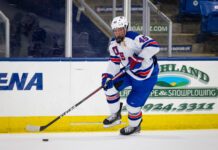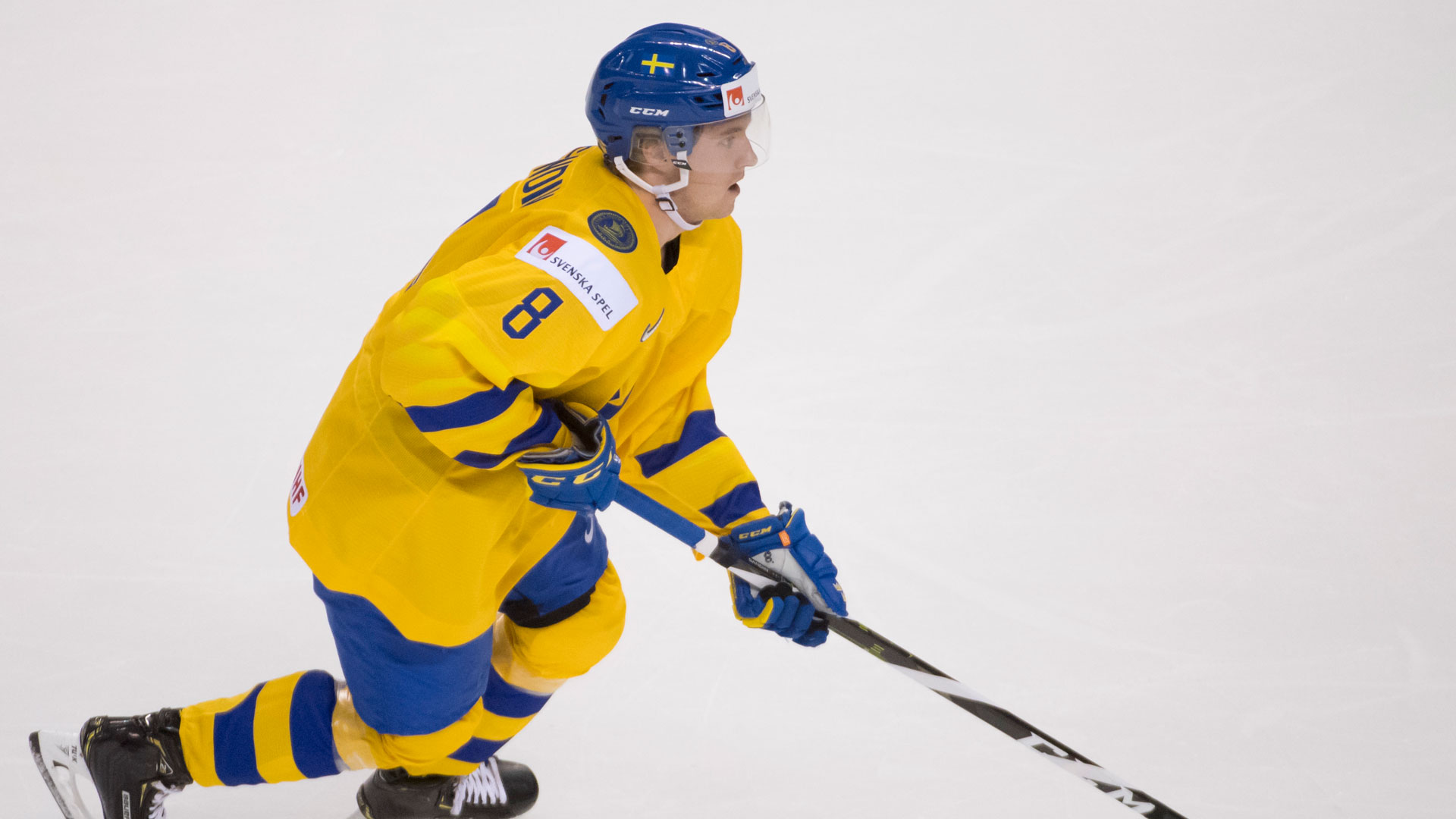The 2020 World Junior Ice Hockey Championships are now in the books after Team Canada completed a third-period comeback over Team Russia to win gold.
Joel Hofer was outstanding, captain Barrett Hayton was resilient, Alexis LaFreniere was a star, and Akil Thomas was the late-game hero:
AKIL THOMAS!! pic.twitter.com/UJY6jSElwn
— Kevin Papetti (@KPapetti) January 5, 2020
This was Canada’s first gold medal won in Europe since 2008, and they’ll be able to defend their championship on home soil next year. Meanwhile, Leafs prospect Rasmus Sandin was named the top defenceman of the tournament and Nick Robertson established himself as one of the best players on Team USA. For many Leafs fans, this was close to a perfect tournament.
Team Canada’s Dramatic Victory
After losing 6-0 to the Russians in the round-robin, Canada found a way to erase a 3-1 third-period deficit when it mattered most. Connor McMichael and Barrett Hayton both found the net before Thomas picked the perfect time to score his first goal of the tournament. They sure got lucky when Aidan Dudas wasn’t penalized for backhanding the puck off the TSN camera, but Russia was gifted a cheap goal earlier in the game on the power play and Team Canada certainly weren’t about to apologize for it.
Canada was the best team in this tournament and they deserved to win. Their goaltender was tremendous, they had star players up-front, and they were stacked on defense with Bowen Byram, Ty Smith, and Jacob Bernard-Docker leading the way. Joe Veleno and Barrett Hayton, outstanding two-way forwards for Canada when they won the Hlinka, followed up those performances perfectly in this event. There was not a forward in this tournament who was as terrifying offensively as Alexis Lafreniere.
I also thought Calen Addison, one of my favourite second-round picks in the 2018 draft, was outstanding all tournament. Aidan Dudas was great on the penalty kill, Connor McMichael was a goal scoring machine, and Liam Foudy emerged as a clear top-six forward. I would have put Alex Newhook on this team and I think they under-utilized Quinton Byfield at times, but this team was still talented enough to get the job done. Ultimately, this was a team that Canada can be proud of.
Rasmus Sandin’s Huge Tournament
Rasmus Sandin started off this tournament with a rough giveaway against Finland, but he quickly rebounded to become the event’s top defenseman. He finished with three goals and seven assists in seven games and it felt like he was putting this team on his back during their final two games. At times, it looked like he simply didn’t belong at this level.
Placed in the easier group this year, Team Sweden really wasn’t challenged against Switzerland, Kazakhstan, or Slovakia. They also dominated the Czech Republic in the quarterfinals, so Sandin looked a little bit out of place for the majority of this event.
Unfortunately, Sweden’s lack of forward depth hurt them against Russia and I think they would have been heavy underdogs had they advanced to the gold medal game against Canada. Samuel Fagemo (LAK) was lethal on the powerplay, Nils Hoglander (VAN) was incredibly entertaining, and David Gustafsson (WPG) was a two-way beast, but I just didn’t see enough lines that could score at five-on-five. Look for Lucas Raymond and Alexander Holtz to put on a show at next year’s tournament, but they weren’t quite starring in this event at 17.
Sandin knocks the puck away to break up a 1-on-1 rush, then throws a big hit for good measure. pic.twitter.com/dCZXz2AdNP
— Kevin Papetti (@KPapetti) December 28, 2019
Rasmus Sandin opens the scoring 16 second in: pic.twitter.com/rIsyOiJ4D6
— Kevin Papetti (@KPapetti) January 4, 2020
Sandin scores his second of the game. His third point.
Sweden ties it at 3. pic.twitter.com/1QMvb8I1w5
— Kevin Papetti (@KPapetti) January 4, 2020
Sandin has some grease in him pic.twitter.com/7sQ9gOQ9Sk
— Nick (@_nickrichard) January 5, 2020
It’s tough to be surprised with Sandin’s success in this tournament, but it’s certainly great to see. I’ve now watched Sandin play in close to 100 games and all signs point to him becoming a valuable NHL defenseman. He’s still not all that fast in a straight line, but he’s an effective puck mover who wins more than his fair share of physical battles. He’s smart and strong enough to factor in on an NHL penalty kill someday and he’s a near lock to play on the power play as well, even over competent puck movers like Jake Muzzin and Travis Dermott.
Sandin creates a healthy amount of zone exits due to his ability to protect the puck, spin away from opposing forecheckers, and pass off his backhand. While he doesn’t have the same type of speed as Quinn Hughes, he sees the ice well and his strength on the puck allows him to wait for the right play to open up. He’s stronger and more physical than Timothy Liljegren was at the same age and he’s a better passer.
If Sandin can get one-step quicker, there won’t be many flaws in his game other than having a short reach. He regularly jumps up into the rush, and while he benefits from playing on the power play with Jeremy Bracco, no one is going to complain about his playmaking anytime soon. He moves fairly well laterally and is strong on his skates, so even if he doesn’t get any faster, the Leafs likely have a future top-four defenseman on their hands in Sandin. His future is bright.
Disappointment for Team USA
The Americans lost a 1-0 game to Finland in the quarter-finals, which gave Canada an easier matchup against Finland. This team was loaded with high-end scorers, but anything can happen in a single-game knockout event and there was plenty of questionable coaching decisions along the way. We will probably look back on their roster and wonder, “How on earth did they lose in the quarterfinals?”, similar to when Canada lost with this roster in 2016.
Trevor Zegras has always been a treat to watch, and even though it’s not clear if he will end up at center or the wing, his playmaking put him 5th back on my 2019 Draft Rankings. Goalies cannot anticipate what he’s going to do next and his teammates constantly end up with tap-in goals as a result.
Cole Caufield’s best game came in the pre-tournament, but I’m still confident that he’s going to be a great goal scorer at the NHL level. I have no idea why they didn’t play him with playmakers like Zegras or Alex Turcotte earlier; they also underutilized him on the power play. He was a victim of bad coaching at times, but his shot is lethal and he’s still eligible to play in next year’s event.
I had high expectations for Nick Robertson, especially after this goal in a pre-tournament game:
Nick Robertson just scored a beauty pic.twitter.com/zbjY2vklM4
— Kevin Papetti (@KPapetti) December 23, 2019
He did not disappoint:
Leafs Nation is drooling. Nick Robertson with traffic in front of him, snipes. #LeafsForever #WorldJuniors2020 pic.twitter.com/fZk8N50y6E
— Josh Tessler (@JoshTessler_) December 26, 2019
The Leafs were lucky to get Robertson, as there was no reason for him to be available at 53rd overall. He was 24th on my board at the draft, but I think he’d be in my top 17 or so if I re-did my rankings today. He’s an energizer bunny who can beat goalies in multiple ways and he’s consistently one of the best players on the ice every time I watch him play.
Robertson will still be eligible for next year’s World Junior tournament, with a chance to be their captain. He’s a volume shooter with a plus wrist-shot, as he utilizes a curl-and-drag move to change the angle on opposing goalies. He can also beat you with a quick one-timer. Even though he’s only 5’9″, he’s not afraid to go to the net to pick up garbage goals. Team USA was using him as the net-front player on the power play, but his shot is more of a weapon in the middle of the 1-3-1, or on his one-timer side.
He’s a shoot-first player rather than a pass-first player, but he’s a fine playmaker when he wants to be and you don’t really want him passing up too many opportunities to use his high-end shot. He’s noticeable on the forecheck — particularly for a player of his size — and is responsible enough defensively to play in any situation.
He reminds me a little bit of Max Domi because of his size and fearlessness. I’ve liked what I’ve seen from Robertson when he played center, as he’s quite strong in battles and it seems like playing up the middle helps him to be a stronger force in the transition game. He’s not the same calibre of playmaker as Domi — and he’d probably have to get even faster to have any type of shot at 70 points — but his shot gives him a serious chance of scoring 25+ goals in a NHL season. A more realistic comparable might be Andreas Johnsson, who scored 20 goals in 73 games last year and isn’t just an empty-calories scorer.
Given his all-around game, I’ll be surprised if he doesn’t become an NHL player in some capacity. He was consistent all tournament long; he does the little things to help his team win even when he’s not scoring, and he’s usually scoring. Ultimately, while Team USA was a disappointment overall, this was a great showing for Robertson from an individual perspective.
Final Notes
- I can’t believe how much talent is coming out of Germany. Tim Stutzle sure looked like a top-five pick in this year’s draft, while Moritz Seider (DET) excelled while playing major minutes. Both Dominik Bokk (CAR) and Jason-John Peterka looked like good NHL prospects and I’m excited to see if this program can continue to grow. I hope Stutzle does not end up in Toronto’s division.
- Mikko Kokkonen was not quite as electrifying as Sandin or Robertson, but he looked fairly strong defensively and is still eligible to play in next year’s event. I loved Matias Maccelli (ARI) in this event and both Ville Heinola (WPG) and Lassi Thomson (OTT) were strong puck movers on the back-end. Rasmus Kupari (LAK) got hurt early on in this tournament; I give credit to Finland for advancing to the semi-finals without him.
- Team Russia had an excellent tournament. Alexander Romanov (MTL) really did it all on the back-end, which was no surprise after he was named the best defenseman of last year’s event. He’s big, strong, fast, and a pretty good puck mover, so expect to see him in Toronto’s division as early as next year. Gregori Denisenko (FLA), Kirill Marchenko (CBJ), and Vasili Podkolzin (RUS) all stood-out up-front, but it was Alexander Khovanov‘s (MIN) two-way play that stood out the most. Look out for Leafs prospect Mikhail Abramov to be a big factor on this team in next year’s event.
All in all, this proved to be a terrific tournament yet again. Congratulations to Team Canada for winning gold and to Rasmus Sandin for being named the top defenseman of the tournament. If Nick Robertson participates, he’s going to put on a show in Red Deer and Edmonton next year. Leafs fans should be pretty excited right now.

































